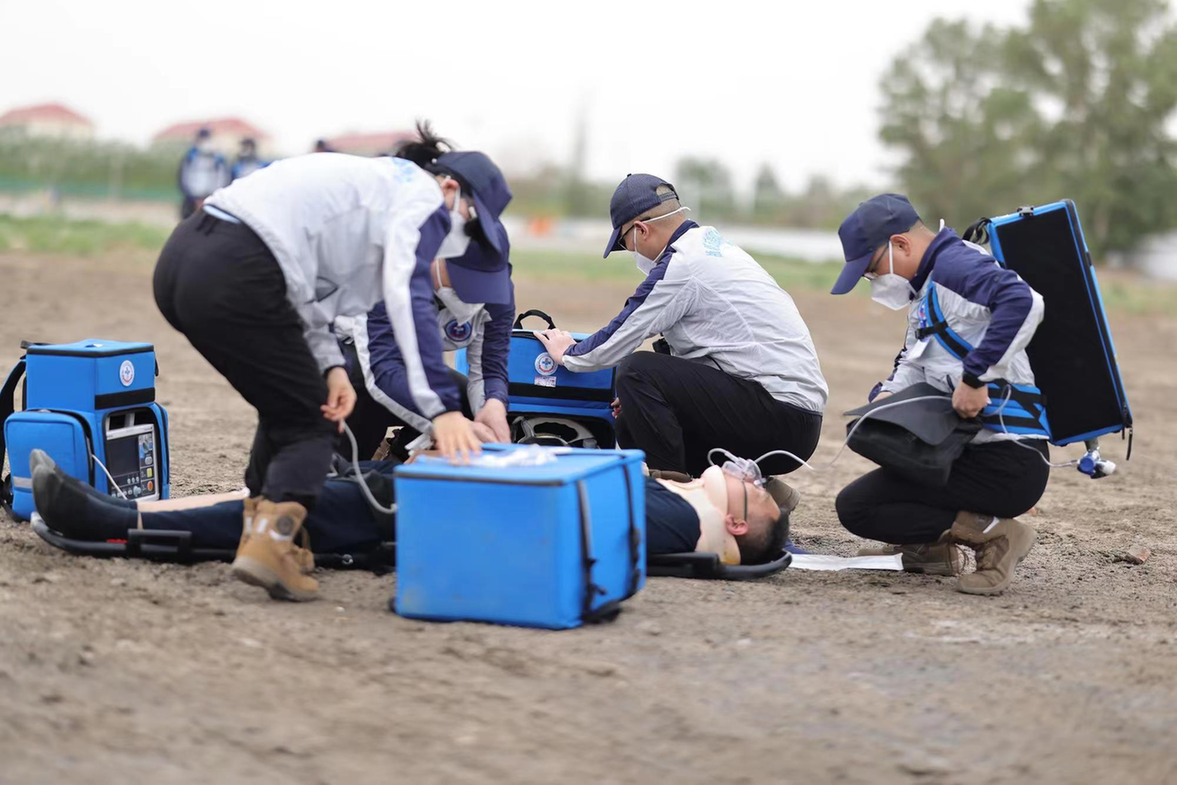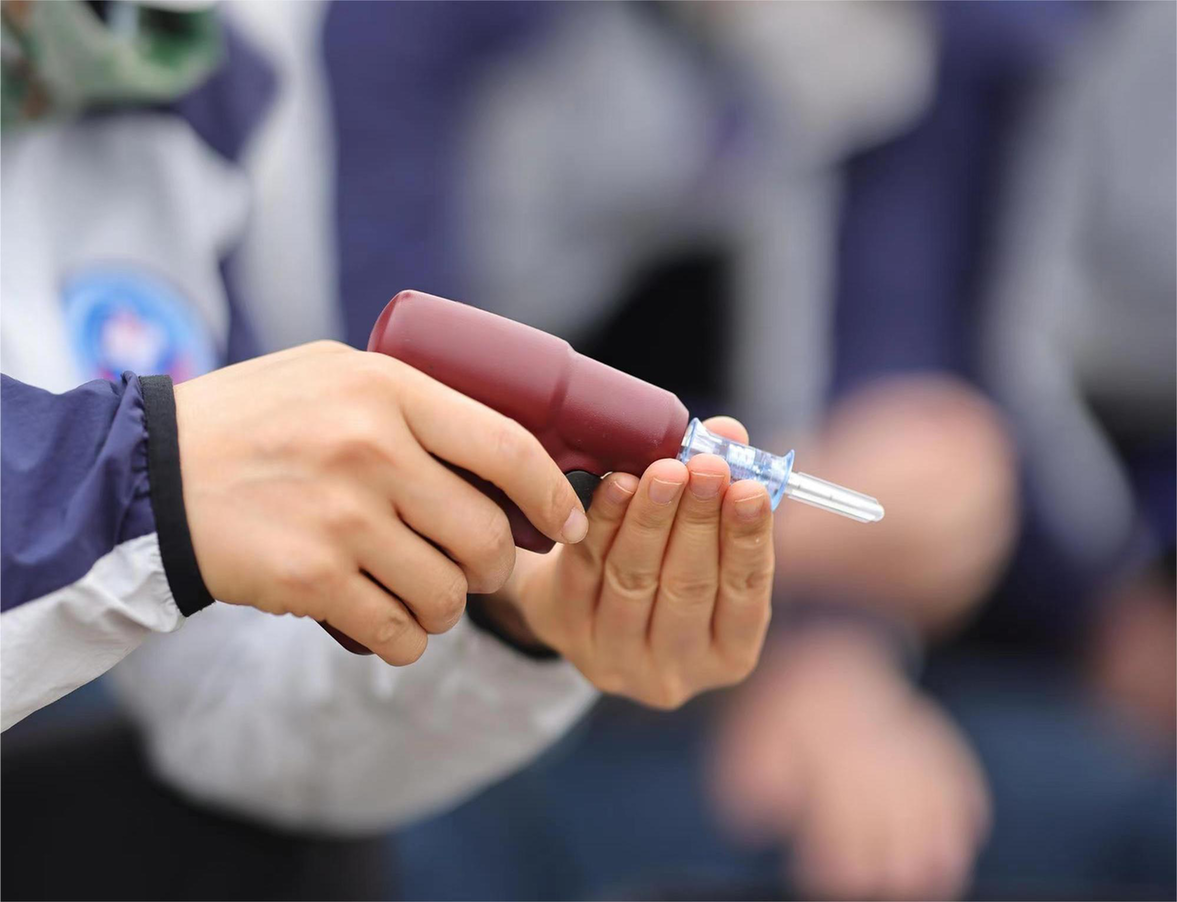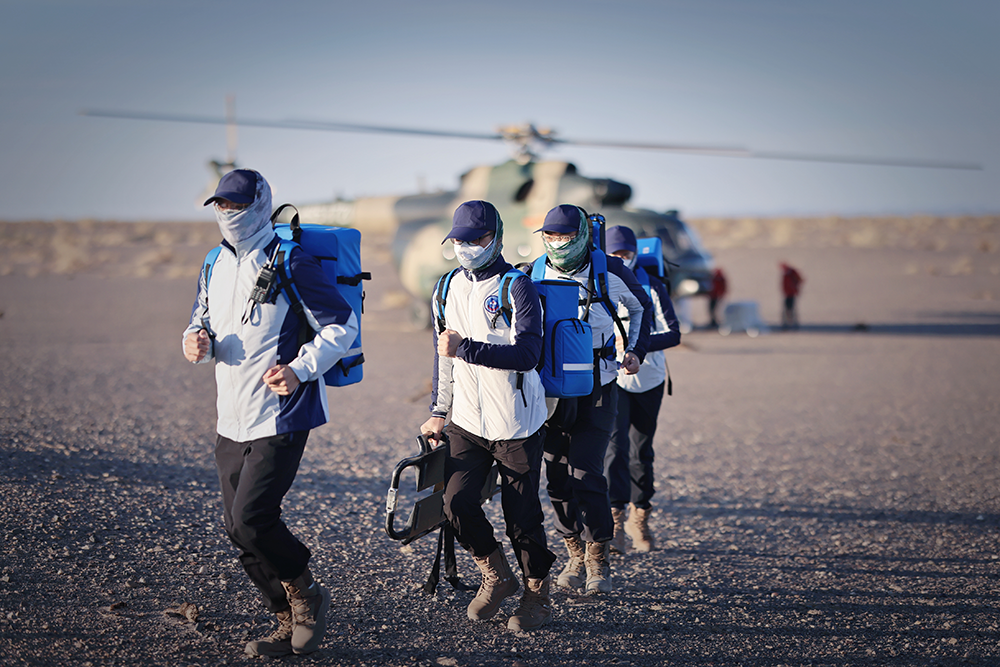Hold up the life insurance umbrella of aerospace heroes
——Documentary of the medical support mission of the medical rescue team of the Shenzhou 15 manned flight mission
Fighting all the way for three thousand miles, holding the aerospace dream on your shoulders!
From the heart capital of the motherland to the depths of the boundless Gobi, the Shenzhou series of manned flight mission medical rescue teams quietly set off with the stars every time, and returned silently in the morning light, faithfully fulfilling the aerospace medical rescue missions entrusted by the party and personnel Responsibility, always ready to escort the aerospace heroes to return safely with the courage to forge ahead without fear of sacrifice, and the technical skills of excellence and hard work. They have successfully completed the previous Shenzhou manned flight medical support missions, and shouldered the mountainous responsibility of escorting the flying dream. In order to welcome the astronauts back home safely, they have worked hard for several days and nights——
Be prepared to make sure nothing goes wrong
The Shenzhou manned mission medical rescue team is a special team. It is special because they cannot be seen on the TV screen, but they always stick to the “bottom line” of astronauts’ life safety. From the Shenzhou 5 to the present, the center’s Shenzhou manned flight mission medical rescue team has gone through 10 Shenzhou launch and recovery missions.
After Shenzhou 14 returns in December 2022, the medical team will transfer to Shenzhou 16 for manned launch and Shenzhou 15 for manned return. “One up and one down” medical support preparations are being prepared, and a team is quickly selected to form a professional guarantee A special task team with honed skills, honed skills, and experienced positions is engaged in intense preparations for work and war. The team includes Chen Zhiming, a “veteran” in medical missions, Peng Xing, a pioneer of anti-epidemic party members, Zhao Lin, a model of distant sea training, Sun Peiming, a model of medical service and martial arts, Sun Yikun, an “expert in surgical skills”, and Zhu Zhu, a “small encyclopedia” in first aid. Ming… old, middle-aged and young people are matched and connected in stages.
This time, they aimed at the fact that the “one-up and one-down” interval of Shenzhou 15 and 16 was only 5 days, the task transition was fast, the preparation time was tight, the support requirements were high, and the early morning operation was difficult. They repeatedly discussed the characteristics, difficulties, and blocking points of the task support. Formed 93 kinds of medical treatment plans in 6 categories of “anti-fatigue and error prevention”, and constructed and optimized a whole set of medical rescue procedures.
“The medical rescue system has two platforms: airborne and vehicle-mounted. Once an astronaut ‘passively leaves the cabin’ or even a bigger accident occurs, these two platforms will reach the return capsule as soon as possible to carry out the rescue mission.” Gao Jun, leader of the medical rescue team Feng introduced. On the ambulance platform, there are more than 1,500 pieces of equipment, 57 kinds of first-aid medicines such as anti-shock drugs and anti-poisoning drugs are ready for use at any time, and there are 28 first-aid surgical kits. The well-equipped and well-equipped ICU is even moved to the helicopter. Operate immediately.

“Chairman Xi pointed out that fighting a war is, in a sense, fighting for security. As a medical rescue team, protecting the lives of astronauts is winning the battle. As long as there is a 0.01% danger, we must be 100% prepared.” Shenzhou Gu Jianwen, captain of the manned mission medical rescue team, introduced. The main landing field covers deserts, hills, lakes, Gobi and other complex terrains. In order to successfully complete the mission, Gu Jianwen did not rest for a moment during the days when he led his team to the landing field. He led the medical team to maneuver 1,800 kilometers in a helicopter, flew over the Badain Jaran Desert, comprehensively inspected the terrain and landforms, meticulously improved the treatment plan, and investigated the emergency medical preparations of the back branch hospital on the spot.
Experts have designed solutions to the most likely injuries when astronauts land on a spacecraft. For example, shock, collision, high temperature, burning and other physical injuries, gas poisoning, decompression sickness, etc., must immediately stop bleeding, bandage, immobilize and other medical first aid. To this end, the medical team formulated detailed rescue plans for a variety of complex injuries such as hypoxia, organ damage, chemical poisoning, craniocerebral injury, external chest injury, and limb injury. The ability to provide timely treatment for various injuries.
Scientific guarantee is only for safe return
“Manned spaceflight is the most complex, difficult, and demanding system engineering in human spaceflight activities. Any small error or mistake may cause great harm to the astronauts. We must do our best to protect the health and safety of the astronauts.” A solid line of defense.” Beginning with the Shenzhou 5 manned spaceflight test mission, this medical team has successfully completed previous astronaut medical rescue support missions. The footsteps of exploration.
Shenzhou V, the first space rescue, relied on rich clinical experience and meticulous logical deduction to fill the gap of “0” in space medical rescue;
Shenzhou 7, for the first time, adopted the method of “one aircraft targeting one person” to carry out rescue, which won precious time for saving lives;
Shenzhou 11 returned in winter for the first time. They carried out field first-aid drills under low-temperature and low-light conditions. They conducted outdoor measurements every hour in winter nights at -18°C, and finally explored a set of heat preservation methods and treatment measures under extreme cold conditions;
Shenzhou 12, for the first time, carried out the whole-process medical rescue support for the spacecraft’s preparation stage, ascent stage, on-orbit flight stage, and return search and rescue stage. It broke the longest record for astronauts in orbit, and systematically sorted out and formed ten typical injuries. Principles to reach expert consensus.
Shenzhou 14 and 15, the first “space rendezvous”, the return of abnormal situations may increase sharply. Faced with new requirements and challenges, the medical team once again launched a charge to the medical highland and successfully completed the task.

Although the medical rescue experts have undergone many batches of nearly 20 years of hard training and repeated running-in, they have already practiced a complete set of first-aid treatment measures, and they have reached the first-class level in terms of rescue technology, drug preparation and medical equipment. All astronauts have made full preparations for possible injuries. However, for the one in ten thousand possibility, they still do not let go of any doubts. They always hope to think more comprehensively, deeply, and carefully. .
Considering that each manned spaceflight medical rescue mission is different, the personnel are different, the on-orbit time is different, and the climate and environment during the return window period are different, the medical team members treat each mission as a new topic to tackle key problems. In order to ensure the success of the mission, the team members comprehensively assessed the safety risks of the Shenzhou 15 return mission, and revised and improved 12 disposal plans including the “Plan for the Implementation of Medical Rescue for Astronauts under Extreme Conditions”. Sun Peiming, a general surgeon who has participated in the medical rescue mission of God 14, said that the possible medical problems of astronauts mainly include space motion sickness, cardiovascular and cerebrovascular diseases, infectious diseases, various pains, and burns with a very low probability of occurrence, acute Abdominal symptoms and other medical emergencies, astronauts may experience landing impact damage, excessive physical exertion, and excessive fatigue under abnormal working conditions after the return segment of the spacecraft and landing. safety of life”. To this end, the team members brainstormed and revised more than 10 times, and finally perfected the medical rescue plan for manned missions, the implementation plan for medical rescue support at the landing site, the possible accidental injuries of astronauts and the first aid process, etc.
“This is a very advanced bone marrow cavity puncture gun in China at present.” team member Sun Xiaowei introduced. In order to improve the first aid capability, while continuously innovating and optimizing the support process and treatment plan, the medical team has also updated and equipped with brand-new defibrillation monitors, ventilators, aspirators and bone marrow puncture guns, and has successively introduced and purchased digital chest drainage systems, Video laryngoscope, backpack carbon fiber oxygen cylinder and other equipment. According to Zhou Junjun, a member of the medical team, the equipment used by the medical team is configured in three sets, plus a spare set; all electrical equipment is equipped with three spare batteries to ensure battery life; all equipment is equipped with operation process cards, and each team member is proficient.

Tried and hammered, willing to be an unsung hero
The ambulance team strives for excellence in every drill. The team members know that although they have worked hard to prepare, the possibility of actually using it is very small, but this is almost a one in ten thousand possibility, and they must avoid it. occur. Through repeated, whole-process, practical drills and repeated discussions on the problems and various possibilities that arise in actual combat, the ambulance team members are familiar with all the countermeasures.
The tense and systematic drills were almost all carried out late at night. The biological clocks of the team members were all disrupted, and sleep became a luxury, but as soon as the order “drill start” was issued, each one of them immediately went into battle with full energy.
“Report to the commander, find the rescue targets No. 01, No. 02, and No. 03, and quickly carry out the inspection.” I saw the medical team members leaning over the door of the cabin and jumping from a height of 15 meters. None of them retreated.

They first lifted the simulated astronaut onto a shovel stretcher, quickly made a judgment on his condition, and immediately escorted him into the ambulance helicopter. Kong Xiangkai issued an order, Zhao Lin delivered oxygen, Zhu Ming started ECG monitoring, Gao Xiaopei established a venous channel… After preliminary injury inspection, first aid was carried out according to the original treatment procedures… The drill ended at 10:00 am the next day, and when they returned to the station, everyone immediately ignored the rest and quickly resumed the drill.
Astronauts have been in orbit for a long time and the geological conditions of the landing site are complex. This series of situations has increased the probability of injuries and made medical rescue more difficult. It is necessary to practice medical rescue skills, arrive in time, diagnose quickly, and deal with them effectively.
Medical first aid “platinum 10 minutes, gold 1 hour”, in order to quickly reach the landing site, the medical rescue team Carry the first aid equipment in front of the cabin with him every day and insist on training for six or seven hours, running in the desert and mountains with heavy loads, striving for the shortest time to start emergency treatment. In summer, the Gobi is scorching hot and full of wind and sand. After a day of training, the players’ ears and eyes are full of sand, their faces and necks are covered with mud marks, and everyone has become a clay figurine. The vast prairie recorded the air-ground collaborative drills of medical rescue and air-ground collaborative drills and global coordinated drills of Shenzhou manned flight mission medical team members…
Hard training in medical rescue skills is a must-have professional ability. Regardless of major or field, everyone competes to learn and practice. The use of bone marrow infusion system for serious illness or first aid on the battlefield is seldom touched at ordinary times, and the medical rescue team specially bought sheep bones for practice. Orthopedic surgeon Qi Hongzhe explained the key points of the operation while practicing, and everyone quickly mastered the operation skills. Cardiovascular physician Mao Shuai trained everyone on the use of portable ultrasound and emergency pericardiocentesis. The medical rescue team is like the “camel thorn” on the Gobi Desert, fighting against the wind and sand, honing the ability of rapid emergency rescue in emergencies, and fighting tenaciously in the front line of medical rescue protection.

For many years, the medical rescue team members of Shenzhou manned missions who escorted the manned spaceflight missions have always been unknown and willing to stay behind. The team members said: “I hope my team will always be a ‘unusable’ team.” Although no one hopes that the on-site medical rescue will eventually come in handy, it is these selfless dedication behind the scenes that make the lives of astronauts Safety becomes more secure.
Reporter: Dong Ge Gaochuan Ma Huizhen
[
责编:宫辞 ]
